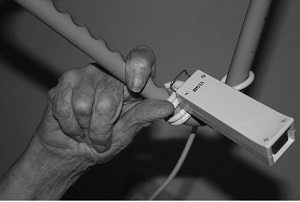
No one, at any age, should ever have to suffer physical abuse, especially nursing home residents who cannot advocate for themselves. Yet, in an empirical study from the National Library of Medicine, close to a quarter of adults older than 65 years have reported at least one incident of physical abuse by nursing home staff. This is clearly unacceptable.
Nursing staff are supposed to take care of residents, not hurt them. Even worse, Adult Protective Services (APS) believes that an overwhelming number of cases of abuse go unreported and untreated each year.
Crowe Arnold & Majors, LLP, Can Help
Don’t let your nursing home physical abuse case go unaddressed. Contact Crowe Arnold & Majors, LLP as soon as possible for immediate assistance. Our passionate Dallas nursing home abuse lawyers do not tolerate the mistreatment of vulnerable, older adults. That is why we have dedicated ourselves to restoring security in the lives of nursing home abuse victims throughout North Texas.
Please don’t hesitate to call us at (214) 231-0555. You may also call our toll-free number (214) 231-0555. We offer a free consultation with a compassionate personal injury lawyer.
No Fee Unless We Win!
What Are My Rights as a Dallas Nursing Home Resident?
While some victims of nursing home physical abuse are very much aware of their situation, others may be unsure of their rights as a resident and, in turn, uncertain whether they are experiencing abuse.
If you or someone you love is the resident of a nursing home, make sure that they are aware of the following rights and protections, and take action if they are being abused:
- Respectful treatment and consideration
- Be free from chemical and physical restraints
- Receive care in a manner and in an environment that promotes maintenance or enhancement of each resident’s quality of life (Texas Administrative Code 19.701-705).
- Receive the necessary care and services to attain or maintain the highest practicable physical, mental, and psychosocial well-being, as defined by and in accordance with the comprehensive assessment and plan of care (Texas Administrative Code 19.901).
For more information, visit the Texas Department of Aging and Disability Services (DADS) webpage. If you suspect the mistreatment of a loved one, you’re encouraged to contact our Dallas nursing home physical abuse attorneys as soon as possible.
Tap Here to Call Our Law Office
Physical Abuse in Nursing Homes Is More Common Than You Think
Abuse in long-term care settings is rarely isolated. It frequently occurs as a pattern of ongoing misconduct that may be concealed, underreported, or gradually normalized within institutional practices, often escaping detection without external scrutiny.
According to the World Health Organization (WHO), 1 in 6 older adults living in community settings has experienced some form of abuse in the past year. Even more troubling, two-thirds of institutional caregivers admit to abusive conduct.
These numbers are likely conservative. Many victims cannot report abuse due to cognitive issues, fear, or communication difficulties. Often, families only uncover the truth when visible injuries or health emergencies demand explanation.
What Constitutes Physical Abuse in a Care Facility?
Physical abuse includes any act that causes, or is likely to cause, physical pain or injury to a resident through the use of intentional force or through actions taken with reckless disregard for the resident’s health and safety. It also encompasses conduct that creates a reasonable fear of imminent physical harm, particularly in residents who are physically or cognitively unable to protect themselves.
This includes but is not limited to:
- Hitting, slapping, pushing, or shoving: Whether during moments of frustration or deliberate punishment, any use of force that injures a resident is abusive.
- Excessive grabbing or pulling: Rough handling when moving, dressing, or repositioning residents can cause serious injury.
- Unauthorized restraints: Using straps, ties, or chemical sedatives without proper medical justification violates residents’ rights.
- Forcing movement against a resident’s will: Twisting limbs or pulling arms during transfers or daily care can cause fractures or dislocations.
- Throwing objects or allowing fights to escalate: Dangerous altercations should be prevented, not ignored.
- Rough or punitive care: Neglecting gentler handling during bathing, toileting, or feeding may be physically and emotionally damaging.
Depending on the circumstances, these actions may constitute assault, battery, reckless endangerment, or negligence under Texas law. While the specific injuries and legal classifications may vary, the underlying legal obligation remains unchanged: nursing homes have a statutory and common law duty to ensure the safety and well-being of their residents.
Staff Members, Other Residents, and Systemic Violence
Physical abuse in a nursing home setting may be perpetrated by a nurse’s aide, a licensed vocational nurse, or even another resident. When a facility fails to prevent foreseeable harm, whether through negligent hiring, lack of staff training, failure to act on warning signs, or inadequate supervision, it may be held liable under Texas tort law.
Facilities have a legal duty to properly screen, train, and supervise their employees and to implement reasonable measures to protect residents from foreseeable harm, including aggression from other residents with known behavioral histories.
When a facility allows hazardous conditions to continue unaddressed, incidents of physical abuse are no longer isolated events; they become foreseeable and preventable consequences of systemic failure.
Tap Here to Call Our Law Office
What Are the Warning Signs of Physical Abuse in Nursing Homes?
Due to cognitive impairment, fear, or dependency, residents may be unable or unwilling to disclose instances of abuse. As a result, families and caregivers often must rely on observable warning signs. While no single sign definitively proves abuse, specific injuries and behavioral changes are commonly associated with physical harm or neglect and should prompt further investigation:
Unexplained Bruises, Broken Bones, or Burns
- Frequent or severe bruising
- Fractures without a documented cause
- Burns or abrasions, especially on sensitive areas
- Injuries described vaguely as “falls” but not witnessed or reported in real-time
Fearful Behavior or Sudden Withdrawal
- Flinching, refusing to be touched
- Reluctance to interact with specific staff
- Sudden changes in mood, including anxiety or depression
- Avoidance of eye contact or social engagement
Staff Refusing Family Access or Providing Vague Explanations
- Denial of visitation or restrictions that seem unjustified
- Delayed responses to questions about injuries
- Staff rotating stories or providing conflicting timelines
- Medical records that lack sufficient detail about significant injuries
These signs often reflect attempts to conceal abuse or neglect. If you notice any of these indicators, it is crucial not to ignore them and to seek professional advice promptly.
When Physical Abuse Causes Fatalities
While actions such as a slap, shove, or forceful grab may not seem life-threatening, they can be fatal in a nursing home setting where residents are often medically fragile. Older adults typically have diminished bone density, thinner skin, slower healing capacity, and rely on others for essential care.
These factors make them especially susceptible to serious or even fatal injuries resulting from physical abuse, even when the force used appears minimal. In such cases, the facility may face liability for wrongful death if it failed to prevent or respond appropriately to the abuse.
Tap Here to Call Our Law Office
How Physical Abuse Leads to Wrongful Death
Certain forms of physical abuse in nursing homes pose a high risk of causing serious injury or death, particularly in elderly or medically compromised residents.
These may include:
- Head trauma from being struck, slammed, or forcibly pushed into walls or furniture
- Fractured hips or limbs resulting from rough or improper handling during transfers or bathing
- Internal injuries, such as bleeding or organ damage, from punches, kicks, or other blunt force trauma
- Choking or asphyxiation due to improper use of restraints or being physically overpowered during care
- Infections caused by untreated or neglected wounds that were inflicted through abuse
- Ongoing assaults by other residents, especially when facility staff fail to intervene or document repeated incidents
In Texas, nursing homes are legally required to take reasonable steps to protect residents from foreseeable harm, including physical violence. Tragically, fatalities resulting from abuse are sometimes misclassified as “natural decline,” particularly in residents with pre-existing conditions. However, patterns of injury and sudden deterioration may indicate abuse or neglect and warrant further investigation.
Nursing homes have a legal duty to protect residents from foreseeable harm, including acts of violence by staff members or other residents. When a facility fails to uphold this duty and that failure results in a resident’s death, it may be held liable under Texas wrongful death law, as outlined in Chapter 71 of the Texas Civil Practice and Remedies Code.
Potential Compensation
A successful civil claim can help families hold the facility accountable and recover compensation for the full scope of harm caused, including:
Economic Damages
Economic damages refer to the tangible, out-of-pocket costs directly resulting from abuse or neglect. In Texas civil cases involving nursing homes, these typically include:
- Emergency medical care — such as emergency room visits, hospitalizations, and surgical interventions
- Ongoing treatment — including physical therapy, pain management, and psychological or psychiatric care
- Future care needs — costs related to increased supervision, assistive services, or transfer to a higher-acuity or more secure facility
- Wrongful death-related expenses — including funeral and burial costs, and in some cases, loss of the decedent’s income or benefits, where applicable
We work with qualified medical and economic experts to accurately calculate these damages, particularly when the abuse results in long-term impairment, permanent disability, or increased care requirements.
Non-Economic Damages
Non-economic damages compensate for the intangible harm your loved one suffered as a result of abuse or neglect. In Texas, these may include:
- Pain and suffering — encompassing physical discomfort, emotional distress, and diminished quality of life
- Mental anguish — including depression, anxiety, fear, emotional withdrawal, and post-traumatic stress
- Loss of dignity — such as humiliation, isolation, or a significant loss of enjoyment in daily life
- Loss of companionship — available in wrongful death cases. The emotional loss of love, comfort, and support formerly provided by the deceased.
These damages can be significant, particularly in cases involving repeated abuse, severe trauma, or long-term psychological impact. While no financial award can undo the harm, compensation serves to recognize the gravity of the wrongdoing and provide a measure of accountability and justice.
Finally, punitive damages are awarded only in cases involving gross negligence, malice, or willful misconduct. When justified, they punish the facility for egregious conduct and deter similar behavior within the long-term care industry.
Why Physical Abuse Happens: Staffing, Training, and Oversight Failures
In many nursing home abuse cases, the root cause is not a single act of cruelty but a broader pattern of systemic failure. Facilities have a legal duty under Texas and federal law to provide care in a safe, supervised environment, with adequately trained and screened staff. When they fall short, due to understaffing, negligent hiring, or ignoring known risks, residents suffer.
Here are three common operational breakdowns that can lead to physical abuse.
Understaffed Facilities and Overworked Aides
Chronic understaffing is a widespread problem in long-term care facilities. When too few aides are responsible for too many residents, the quality of care suffers. Overworked staff may become impatient, careless, or even aggressive, especially when handling physically or cognitively impaired residents.
Poor Hiring and Lack of Supervision
Facilities are obligated to screen prospective employees for criminal backgrounds, professional licensing issues, and suitability for working with vulnerable populations. Yet some homes fail to conduct thorough background checks or overlook red flags to fill staffing shortages quickly.
Additionally, without adequate oversight, unqualified or poorly trained employees may use excessive force during transfers or react abusively to behavioral issues.
History of Prior Abuse or Neglect Complaints
Some facilities have a documented history of abuse allegations, regulatory violations, or substantiated complaints. When management fails to address these issues, such as by retraining staff, increasing monitoring, or reporting suspected abuse, they place residents at continued risk. Ignoring a known pattern of harm may rise to the level of gross negligence, particularly if further abuse occurs.
How Our Legal Team Investigates Nursing Home Abuse
When a nursing home resident suffers a serious injury or dies under suspicious circumstances, facilities rarely offer a complete or transparent account, especially if the facts may expose liability:
- Our investigation begins with a detailed review of the resident’s medical records, daily care logs, and nursing notes. We look for missing documentation, inconsistencies in treatment timelines, and lapses in monitoring, particularly following reported incidents or complaints.
- We then examine staff schedules and available surveillance footage to assess whether the reported narrative aligns with the evidence. By cross-referencing injury timelines with staffing rosters, we can evaluate whether adequate supervision was in place and identify who was on duty when key events occurred.
- We also interview individuals with firsthand knowledge, such as former staff, residents, or family members, including whistleblowers who can provide insights not captured in the records.
- To understand the broader context, we analyze the facility’s regulatory history, including past inspection results, citations, and complaints. Patterns of abuse, chronic understaffing, or repeated safety violations often reveal systemic failures.
- When necessary, we consult independent medical experts and elder care professionals to interpret clinical findings and determine whether the harm was preventable under proper care standards.
This fact-driven approach allows us to build a compelling case based on clear evidence and expert analysis.
Serious Representation for Serious Nursing Home Abuse Cases
At Crowe Arnold & Majors, LLP, we handle high-stakes cases involving serious physical abuse in nursing homes because they demand precision, focus, and unwavering advocacy. These are complex cases that deserve time, significant resources, and a legal team that knows where to look and how to hold wrongdoers accountable.
We work on a contingency fee basis, meaning you will not owe legal fees unless we win your case. This ensures that financial concerns will not prevent you from securing strong legal support.
Contact us today for a free, no-obligation consultation with a nursing home physical abuse lawyer.

John W. Arnold,
Partner, Trial and Appellate Attorney
With over 25 years of experience, John is a seasoned trial and appellate attorney known for delivering results.

David W. Crowe
Partner, Personal Injury
For more than 30 years, David has been a powerful advocate and fighting for individuals harmed by negligence and abuse.

D.G. Majors
Trial Attorney, Personal Injury and Product Liability
D.G. is a trial lawyer with a strong track record of results in personal injury, product liability, and commercial litigation.
Our Dallas Location
6550 Bank of America Plaza
901 Main St.
P: 214-231-0555
Additional Information
- Elder Physical Abuse – U.S. Department of Justice: https://www.justice.gov/elderjustice/physical-abuse
- Elder Abuse: Know the Signs: https://www.webmd.com/healthy-aging/elder-abuse-signs#1-2
- Elder Abuse Facts – National Council on Aging: https://www.ncoa.org/public-policy-action/elder-justice/elder-abuse-facts/





